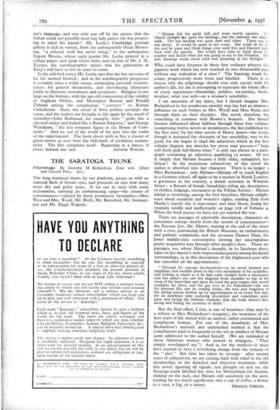THE SARATOGA TRUNK
Pilgrimage. By Dorothy M. Richardson. Four vols. (Dent and Cresset Press. 3os.)
Tim long trainload draws by our platform, passes us with an inimical flash of female eyes, and proceeds on into how many more dry and gritty years. It set out in 1915 with some acclamation, carrying its embarrassing cargo—the stream of consciousness—saluted by many prominent bystanders—Miss West and Mrs. Woolf, Mr. Wells, Mr. Beresford, Mr. Swinner- ton and Mr. Hugh Walpole :
`..`Miriani...left the gaslit hall and went slowly upstairs. Ti March twilight-My upon-the landings,-but-the staircase was -ahno dark. The top landing was quite dark and silent. There was I. one about. It would be quiet in her room. She could sit by th_• lire 'and be quiet and think things over until Eve and Harriett came back with the parcels. She would have time to think about the journey and decide what she was going to say to the Fraulein. Her near Saratoga trunk stood solid and gleaming in the firelight."
Who could have foreseen in those first ordinary phrases this gigantic work which has now reached its two thousandth page
without any indication of a close ? The Saratoga trunk be-
comes progressively more worn and labelled. There is no reason why the pilgrimage should ever end, except with the author's life, for she is attempting to represent the whole effect of every experience—friendship, politics, tea-parties, books, weather, what you will—on a woman's sensibility.
am uncertain of my dates, but I should imagine Miss
Richardson in her ponderous unwitty way has had an immense influence on such writers as Mrs. Woolf and Miss Stein, and through them on their disciples. Her novel, therefore, has something in common with Bowles's Sonnets. She herself became influenced-about halfway through -these four volumes (comprising twelve novels or instalments, the-last published for the first time) by the later novels of Henry James—the result, though it increased the obscurity of her sensibility, was to the
good, for she began to shed the adjectives which in the first volume disguise any muscles her prose may possess—" large soft fresh pink full-blovin roses " is only one phrase in a para- graph containing 41 adjectives qualifying x5 nouns. Or was it simply that Miriam became a little older, unhappier, less lyrical ? In the monstrous subjectivity of this novel the author is absorbed into her character. There is no longer a Miss Richardson : only Miriam—Miriam off to teach English in-a German school, off again to be a teacher in North London, a governess in the country, a dental secretary in Wimpole Street : a flotsam of female friendships piling up, descriptions of clothes, lodgings, encounters at the Fabian Society : Miriam taking to reviewing, among the first bicyclists; Miriam enlight- ened about socialism and women's rights, reading Zola from Mudie's (surely this is inaccurate) and later Ibsen, losing her
virginity tardily and ineffectually on page 218 of Volume 4. When the book pauses we have not yet reached the war.
There are passages of admirable description, characters do sometimes emerge clearly from the stream of consciousness— the Russian Jew, Mr. Shatov, waiting at the end of the street with a rose, patronising the British Museum, an embarrassing and pathetic companion, and the ex-nurse Eleanor Dear, the
lower middle-class consumptive clawing her unscrupulous pretty acquisitive way through other people's lives. There are passages, too, where Miriam's thought, in its Jacobean dress, takes on her master's wide impressionist poetry among the dental surroundings, as in this description of the frightened peer who has cancelled all his appointments : " Through his staccato incoherencies—as he stood shamed and suppliant, and sociable down to the very movement of his eyelashes, and looking so much as if he had come straight from a racecourse that her mind's eye saw the diagonal from shoulder to hip of the strap of his binoculars and upon his head the grey topper that would complete his dress, and the gay rose in his buttonhole—she saw his pleasant life, saw its coming weeks, the best and brightest of the spring season, broken up by appointments to Sit, every few days for an indefinite time enduring discomfort and sometimes acute pain, and facing the intimate reminder that the body doesn't last, facing and feeling the certainty of death."
But the final effect, I fear, is one of weariness (that may be a tribute to Miss Richardson's integrity), the weariness of the best years of life shared with an earnest, rather sentimental and complacent woman. For one of the drawbacks of Miss Richardson's unironic and undetached method is that the compliments paid so frequently to the wit or intellect of Miriam seem addressed to the author herself. (We are reminded of those American women who remark to strangers, " They simply worshipped me.") And as for the method—it must have seemed in 15a5 a revivifying change from the tyranny of the " plot." But time has taken its revenge : after twenty years of subjectivity, we are turning back with relief to the old dictatorship, to the detached and objective treatment, while this novel, ignoring all signals, just ploughs on and on, the Saratoga trunk labelled this time for Switzerland, for Austria, shaking on the lack, and Miriam still sensitively on the alert, reading far too much significance into a cup of coffee, a flower in a vase, a fog, or a sunset. GRAHAM GREENE. . _ -










































 Previous page
Previous page